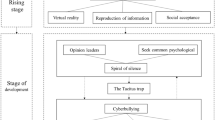Abstract
The impact of Cyberculture, of digital devices on young people as extensions of the body, can be seen in terms of the decreasing structuring of thoughts and information, increasing impulsivity in perception and action, and the development of more primitive defense mechanisms. These adverse impacts result in the feeling of isolation and devaluation, frustration of present and uncertainty of the future, exteriorization and floating identities, mimetic and adhesive identifications, less cohesion of the self, and decreasing tolerance of the other. This paper focuses on the following themes: Symbiosis versus syncretism: The affirmations of symbiosis. The dilutions of syncretism. Synopsis: Too much syncretism, too little symbiosis. Lack of a deeper co-construction of knowledge, more lasting, and sustainable. Lack of increased more independent personal cognitive deepening. Lack of ability to be alone. Causality and free will: Symbiotic versus syncretic causality. Conclusions: Cyber-selfs—either distributed or not at all?
Similar content being viewed by others
Notes
Accessed at https://en.wikipedia.org/wiki/Cybernetics.
Accessed at https://www.infopedia.pt/dicionarios/lingua-portuguesa/simbiose?ic-click. This extended article is the outcome, in English, of an invited speaker presentation, in Portuguese, at “Congresso de Cibercultura” http://www.cibercultura2016.net, 13–14 Outubro de 2016, Braga, Portugal. Hence the lookup of terms in a public online dictionary of Portuguese. The corresponding article in Portuguese will appear in local proceedings.
References
Bilbao A (2016) O cérebro da criança explicado aos pais. Editorial Planeta, Lisbon
Gonçalves MJ (2016) Nascer e Crescer na Era Digital. Talk on 31 de Março de 2016. Sociedade Portuguesa de Psicanálise, Lisbon
Kardaras N (2016) Glow kids. St. Martin’s Press, New York
Lemma A (2013) Introduction to the practice of psychoanalytic psychotherapy. Wiley, Hoboken
Pereira JP (2016a) A ascensão da nova ignorância. Público online. https://www.publico.pt/2016/12/31/sociedade/noticia/a-ascensao-da-nova-ignorancia-1756629. Accessed 31 Dec 2016
Pereira LM (2016b) Software sans emotions but with ethical discernment. In: Silva S (ed) Morality and emotion: (un)conscious journey into being. Routledge, London, pp 83–98
Pereira LM, Saptawijaya A (2016) Programming machine ethics. Studies in applied philosophy, epistemology and rational ethics, vol 26. Springer, Berlin
Roland A (1988) In search of self in India and Japan: toward a cross-cultural psychology. Princeton University Press, Princeton
Turkle S (2011) Alone together: why we expect more from technology and less from each other. The MIT Press, Cambridge
Wiener N (1948) Cybernetics: or control and communication in the animal and the machine. The MIT Press, Cambridge
Acknowledgements
The author thanks the comments of João Vasconcelos Costa, Graça Figueiredo Dias, António Lopes and Jeffrey White. The support of FCT/MEC NOVA LINCS PEst UID/CEC/04516/2013 is manifested.
Author information
Authors and Affiliations
Corresponding author
Rights and permissions
About this article
Cite this article
Pereira, L.M. Cyberculture, symbiosis, and syncretism. AI & Soc 33, 447–452 (2018). https://doi.org/10.1007/s00146-017-0715-6
Received:
Accepted:
Published:
Issue Date:
DOI: https://doi.org/10.1007/s00146-017-0715-6




